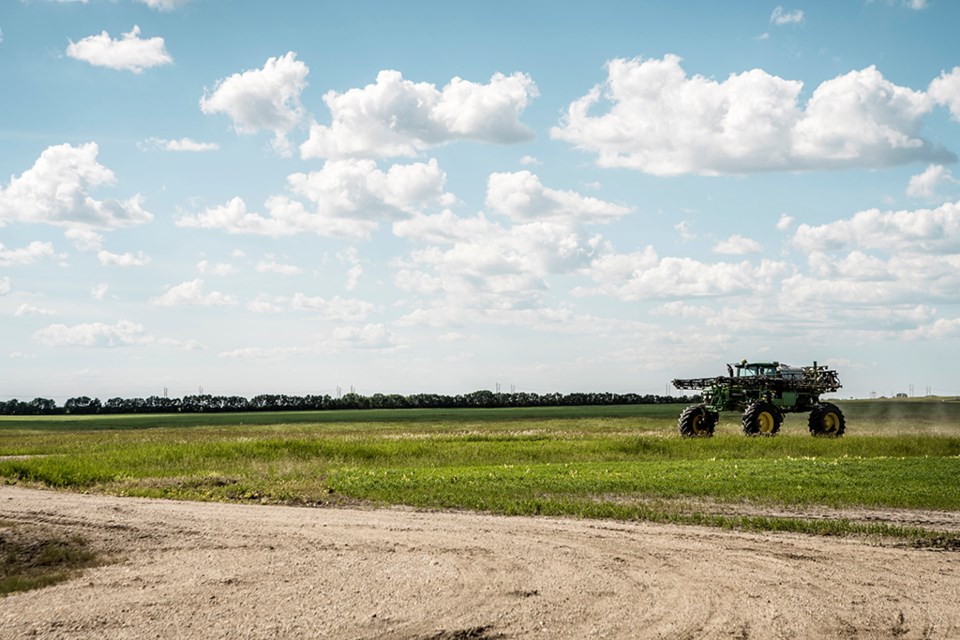WEST-CENTRAL SASKATCHEWAN CROP REGION — Producers in the West-Central Saskatchewan Crop Region have been able to make very good progress with seeding over the past week. Ninety-five per cent of the crop has now been seeded, this is slightly ahead of the five-year average (2017-2021) of 91 per cent. Now that seeding is practically complete in the region, rain is needed.
Ninety-nine per cent of the field peas and lentil acres, 97 per cent of the mustard, 96 per cent of the durum, 95 per cent of the canola, 93 per cent of the spring wheat, 89 per cent barley, 87 per cent flax and 82 per cent oats have been seeded to date in the region.
Very little rain was received this past week, combined with severely windy, days the topsoil moisture conditions in the region continue to struggle. The Macklin area received the most rain with 7.5 mm, the Eyebrow area three mm and the Rose town area to mm. These minimal amounts of rain will do little for seeded crops and pasture land. Producers are hoping for substantial rain soon.
Cropland topsoil moisture is rated as 21 per cent adequate, 50 per cent short and 29 per cent very short. Hay and pasture land topsoil moisture is rated as 21 per cent adequate, 44 per cent short and 35 per cent very short.
Most crops are in good to fair condition, but they will quickly deteriorate if rain is not received in the coming weeks. Seeded crops have been slow to germinate and emergence is spotty due to the lack of moisture, some areas that have missed the rain entirely have had almost none of their crop emerge. Strong winds have prevented many producers from С����Ƶ able to spray, but in-crop spraying is starting in the region now that weed growth has increased. Most of the crop damage this week was due to wind, dry conditions, flea beetles and gophers.
Producers are busy wrapping up seeding, in-crop spraying as wind conditions allow, rolling pulses, and picking rocks.
Provincial Overview
Producers in the west are nearly wrapped up with seeding while many in the east are still behind due to rain delays and extremely wet fields.
Currently, 76 per cent of the crop acres in the province have been seeded, up from 52 per cent last week but still well behind the five-year average (2017-2021) of 93 per cent. Producers in the southeast and east central regions have reported that many low laying areas will go unseeded this year due to standing water.
Ninety-seven per cent of the crop is seeded in the southwest, 95 per cent in the west-central, 93 per cent in the northwest, 64 per cent per cent in the southeast, 60 per cent in the northeast and 50 per cent in the east-central region.
Provincially, 96 per cent of lentils and chickpeas, 93 per cent of field peas, 91 per cent of durum, 79 per cent of canary seed, 75 per cent of spring wheat, 69 per cent of barley, 66 per cent of canola, 65 per cent of flax and 51 per cent of oats have been seeded to date.
A large weather system covered much of the eastern part of the province this past week, resulting in significant amounts of rain for those regions. The Moosomin area received 92 mm, the Stoughton area 89 mm, the Bienfait area 65 mm and the Esterhazy area 42 mm. The west received some rain over the past week, but amounts were small, ranging from three mm to 12 mm.
Cropland topsoil moisture is rated as 16 per cent surplus, 56 per cent adequate, 19 per cent short and nine per cent very short. Hay and pasture land topsoil moisture is rated as seven per cent surplus, 60 per cent adequate, 19 per cent short and 14 per cent very short. Western regions are least favourable for moisture while more favourable conditions are reported in the east.
Crop conditions this week range from good to fair across the province. Emergence has been reported to be slow in areas of the southwest and west-central where moisture is lacking. In the southeast and east-central, however, emergence has been slow due to cool weather and an overabundance of moisture. Most crop damage this week was from flooding, drought, flea beetles and gophers.
Now that seeding has wrapped up for many producers, they are busying spraying in-crop herbicides, assessing germination and emergence, scouting for early season pests and moving cattle to pasture.




